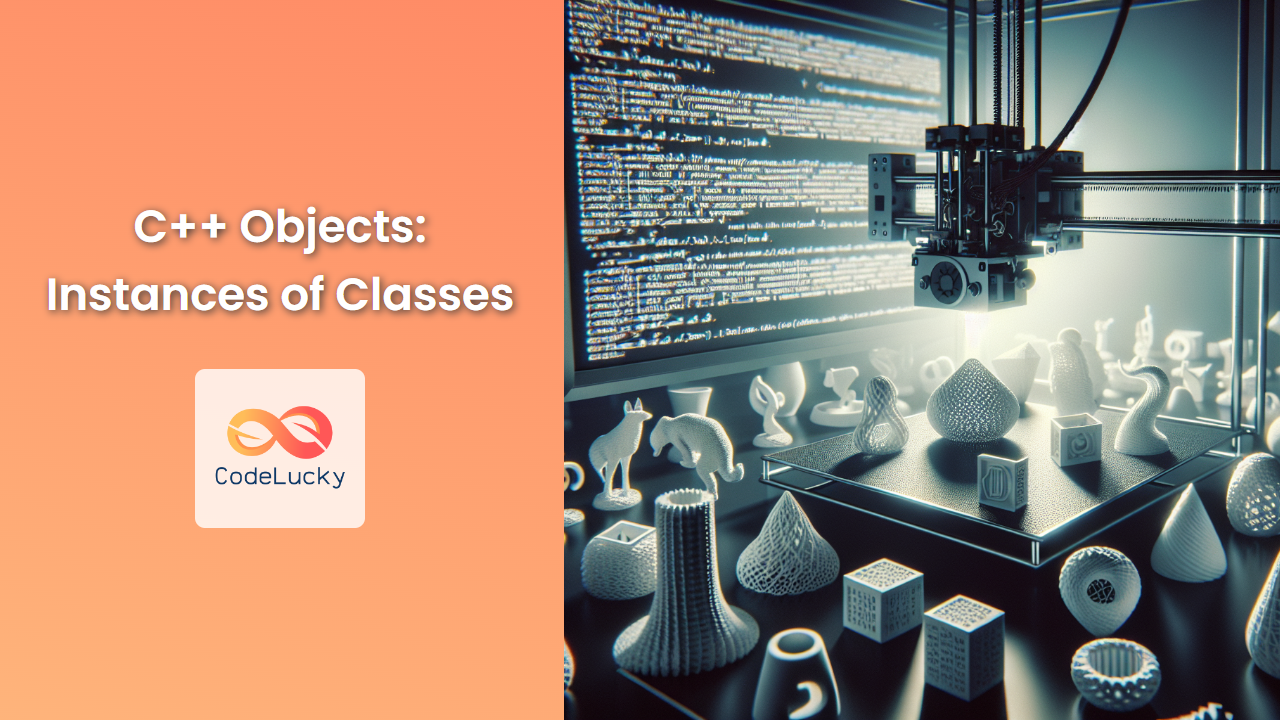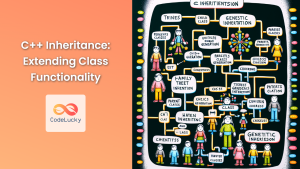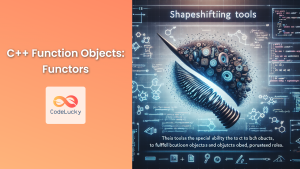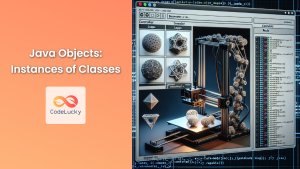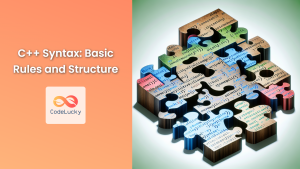In the world of C++, objects are the beating heart of object-oriented programming (OOP). They are the tangible manifestations of classes, bringing abstract concepts to life in your code. Understanding objects is crucial for any C++ developer looking to harness the full power of OOP. In this comprehensive guide, we'll dive deep into C++ objects, exploring their creation, manipulation, and the myriad ways they can enhance your programming prowess.
What Are C++ Objects?
🔍 Objects in C++ are instances of classes. Think of a class as a blueprint and an object as the actual building constructed from that blueprint. Each object contains its own set of data members (attributes) and can perform actions through its member functions (methods).
Let's start with a simple example to illustrate this concept:
class Car {
public:
string brand;
string model;
int year;
void displayInfo() {
cout << year << " " << brand << " " << model << endl;
}
};
int main() {
Car myCar; // Creating an object of the Car class
myCar.brand = "Toyota";
myCar.model = "Corolla";
myCar.year = 2022;
myCar.displayInfo(); // Calling a member function
return 0;
}
Output:
2022 Toyota Corolla
In this example, myCar is an object of the Car class. It has its own set of attributes (brand, model, year) and can call the displayInfo() method.
Creating Objects in C++
There are several ways to create objects in C++. Let's explore each method:
1. Stack Allocation
This is the simplest way to create an object. The object is automatically destroyed when it goes out of scope.
class Rectangle {
public:
int width, height;
};
int main() {
Rectangle rect; // Stack allocation
rect.width = 5;
rect.height = 3;
cout << "Area: " << rect.width * rect.height << endl;
return 0;
}
Output:
Area: 15
2. Heap Allocation
Objects can be dynamically allocated on the heap using the new keyword. Remember to delete these objects when they're no longer needed to prevent memory leaks.
class Circle {
public:
double radius;
double area() {
return 3.14159 * radius * radius;
}
};
int main() {
Circle* pCircle = new Circle(); // Heap allocation
pCircle->radius = 2.5;
cout << "Area: " << pCircle->area() << endl;
delete pCircle; // Don't forget to free the memory!
return 0;
}
Output:
Area: 19.6349
3. Array of Objects
You can create multiple objects at once using an array:
class Point {
public:
int x, y;
};
int main() {
Point points[3]; // Array of 3 Point objects
for (int i = 0; i < 3; i++) {
points[i].x = i;
points[i].y = i * 2;
}
for (int i = 0; i < 3; i++) {
cout << "Point " << i << ": (" << points[i].x << ", " << points[i].y << ")" << endl;
}
return 0;
}
Output:
Point 0: (0, 0)
Point 1: (1, 2)
Point 2: (2, 4)
Object Initialization
Proper initialization of objects is crucial for maintaining data integrity. C++ provides several ways to initialize objects:
1. Default Constructor
If no constructor is defined, C++ provides a default constructor that initializes primitive types to zero and calls the default constructors of member objects.
class Book {
public:
string title;
int pages;
};
int main() {
Book myBook; // Default constructor called
cout << "Title: " << myBook.title << ", Pages: " << myBook.pages << endl;
return 0;
}
Output:
Title: , Pages: 0
2. Parameterized Constructor
You can define a constructor that takes parameters to initialize the object:
class Student {
public:
string name;
int age;
Student(string n, int a) : name(n), age(a) {}
};
int main() {
Student alice("Alice", 20);
cout << alice.name << " is " << alice.age << " years old." << endl;
return 0;
}
Output:
Alice is 20 years old.
3. Initializer List
C++11 introduced a uniform initialization syntax using braces:
class Vector3D {
public:
double x, y, z;
};
int main() {
Vector3D v1 = {1.0, 2.0, 3.0};
Vector3D v2{4.0, 5.0, 6.0}; // Equivalent to the above
cout << "v1: (" << v1.x << ", " << v1.y << ", " << v1.z << ")" << endl;
cout << "v2: (" << v2.x << ", " << v2.y << ", " << v2.z << ")" << endl;
return 0;
}
Output:
v1: (1, 2, 3)
v2: (4, 5, 6)
Object Composition
Objects can contain other objects as members, allowing for complex data structures:
class Engine {
public:
int horsepower;
Engine(int hp) : horsepower(hp) {}
};
class Car {
public:
string brand;
Engine engine;
Car(string b, int hp) : brand(b), engine(hp) {}
void displayInfo() {
cout << brand << " with " << engine.horsepower << " HP engine" << endl;
}
};
int main() {
Car myCar("Ferrari", 660);
myCar.displayInfo();
return 0;
}
Output:
Ferrari with 660 HP engine
Object Lifecycle
Understanding the lifecycle of objects is crucial for efficient memory management:
- Creation: Objects are created and memory is allocated.
- Initialization: Constructors are called to set initial values.
- Usage: Objects are used in the program.
- Destruction: Destructors are called, and memory is freed.
Let's see this in action:
class LifecycleDemo {
public:
LifecycleDemo() {
cout << "Object created" << endl;
}
~LifecycleDemo() {
cout << "Object destroyed" << endl;
}
void doSomething() {
cout << "Object in use" << endl;
}
};
int main() {
cout << "Entering main" << endl;
{
LifecycleDemo obj;
obj.doSomething();
} // obj goes out of scope here
cout << "Exiting main" << endl;
return 0;
}
Output:
Entering main
Object created
Object in use
Object destroyed
Exiting main
Advanced Object Concepts
1. Const Objects
Const objects cannot modify their data members:
class ConstDemo {
public:
int value;
ConstDemo(int v) : value(v) {}
int getValue() const {
return value;
}
};
int main() {
const ConstDemo obj(42);
cout << "Value: " << obj.getValue() << endl;
// obj.value = 10; // This would cause a compilation error
return 0;
}
Output:
Value: 42
2. Static Members
Static members are shared among all objects of a class:
class Counter {
public:
static int count;
Counter() {
count++;
}
};
int Counter::count = 0; // Initialize static member
int main() {
Counter c1, c2, c3;
cout << "Number of objects created: " << Counter::count << endl;
return 0;
}
Output:
Number of objects created: 3
3. Friend Functions
Friend functions can access private members of a class:
class PrivateAccess {
private:
int secretValue;
public:
PrivateAccess(int v) : secretValue(v) {}
friend void revealSecret(const PrivateAccess& obj);
};
void revealSecret(const PrivateAccess& obj) {
cout << "The secret value is: " << obj.secretValue << endl;
}
int main() {
PrivateAccess obj(1234);
revealSecret(obj);
return 0;
}
Output:
The secret value is: 1234
Best Practices for Working with Objects
-
🛠️ Use constructors for proper initialization: Always initialize your objects to a valid state.
-
🧹 Implement destructors for cleanup: If your class allocates resources, ensure they're properly released.
-
🔒 Encapsulate data: Use private members and public methods to control access to object data.
-
📚 Follow the Rule of Three (or Five): If you implement any of destructor, copy constructor, or copy assignment operator, you should probably implement all three (and move constructor and move assignment in C++11).
-
🚫 Avoid unnecessary object copying: Use references or pointers when passing objects to functions, unless you specifically need a copy.
-
🏗️ Use object composition: Build complex objects by composing simpler objects, rather than through inheritance when possible.
-
🔍 Const correctness: Use const for objects and methods that don't modify state.
Conclusion
Objects are the cornerstone of object-oriented programming in C++. They allow you to create complex, reusable, and maintainable code by encapsulating data and behavior. By mastering the creation, initialization, and manipulation of objects, you'll be well on your way to becoming a proficient C++ programmer.
Remember, practice is key to truly understanding these concepts. Experiment with different class designs, object interactions, and advanced features to solidify your knowledge. Happy coding! 🚀💻

